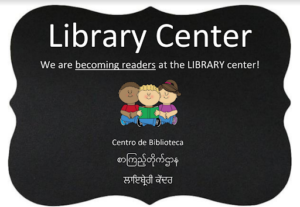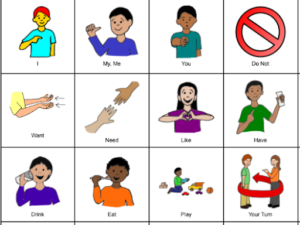Supporting Dual Language Learners in any educational setting can be a task that even the most experienced educator can struggle with. As we try to help our students learn a new language and culture, we also want to honor their community, their families, and their experiences. Given the changing demographics of many communities, it is crucial to create a classroom environment that is responsive and inclusive for all students who enter the doorway each day.  Creating an environment that is warm and welcoming for all students should be the goal of each teacher and staff member in an early childhood setting. It’s critical to represent all learners in the classroom. This can be accomplished through a wide variety of children’s literature, multicultural pictures displayed throughout the classroom, and displaying different languages throughout the classroom. Teachers should use a wide variety of formal and informal means to showcase different cultures and languages. In our classrooms, we have center labels translated into multiple languages, visuals displayed with word pairings in multiple languages, and family photos showcased throughout the room. Our classroom libraries are also full of books that represent children from all different countries and communities. This allows children to see themselves represented in all they do throughout the early childhood classroom. Exposing children to cross-language spaces allows children to compare languages throughout their daily interactions with peers and adults. In a recent publication from NAEYC, The Essentials, Supporting Dual Language Learners in Diverse Environments in Preschool and Kindergarten, authors Alanis, Arreguin, and Salinas-Gonzalez explain these purposefully planned activities allow children to build and transfer their knowledge in multiple ways throughout their day. They suggest different activities such as, “Read the Room” in different languages on different days. The key to this work is that the activities are planned and purposeful. As teachers are planning circle time activities such as reading rhymes, playing I Spy, or doing calendar activities, incorporating dual languages can be incredibly beneficial for all students. When teachers create a print rich classroom, words are everywhere. Students are seeing multiple languages in multiple places throughout the classroom and are able to assimilate what they learn from one environment to the next. Teachers do not need to be fluent in dual languages, just exposing students to the dual language will enhance the language skills of all learners.
Creating an environment that is warm and welcoming for all students should be the goal of each teacher and staff member in an early childhood setting. It’s critical to represent all learners in the classroom. This can be accomplished through a wide variety of children’s literature, multicultural pictures displayed throughout the classroom, and displaying different languages throughout the classroom. Teachers should use a wide variety of formal and informal means to showcase different cultures and languages. In our classrooms, we have center labels translated into multiple languages, visuals displayed with word pairings in multiple languages, and family photos showcased throughout the room. Our classroom libraries are also full of books that represent children from all different countries and communities. This allows children to see themselves represented in all they do throughout the early childhood classroom. Exposing children to cross-language spaces allows children to compare languages throughout their daily interactions with peers and adults. In a recent publication from NAEYC, The Essentials, Supporting Dual Language Learners in Diverse Environments in Preschool and Kindergarten, authors Alanis, Arreguin, and Salinas-Gonzalez explain these purposefully planned activities allow children to build and transfer their knowledge in multiple ways throughout their day. They suggest different activities such as, “Read the Room” in different languages on different days. The key to this work is that the activities are planned and purposeful. As teachers are planning circle time activities such as reading rhymes, playing I Spy, or doing calendar activities, incorporating dual languages can be incredibly beneficial for all students. When teachers create a print rich classroom, words are everywhere. Students are seeing multiple languages in multiple places throughout the classroom and are able to assimilate what they learn from one environment to the next. Teachers do not need to be fluent in dual languages, just exposing students to the dual language will enhance the language skills of all learners.
“Teachers do not need to be fluent in dual languages, just exposing students to the dual language will enhance the language skills of all learners.”
 As teachers look towards supporting multilingual students in their classrooms, there are several essential supports which are crucial for teachers to implement in their classrooms. To begin with, a structured routine that is predictable and clear can benefit all students, especially those dual language learners in the classroom. The use of visual supports, visual schedule or core communication boards can also be very effective for all learners. These tools will help students with the day to day routine of the classroom but also with transitions that take place throughout the day.
As teachers look towards supporting multilingual students in their classrooms, there are several essential supports which are crucial for teachers to implement in their classrooms. To begin with, a structured routine that is predictable and clear can benefit all students, especially those dual language learners in the classroom. The use of visual supports, visual schedule or core communication boards can also be very effective for all learners. These tools will help students with the day to day routine of the classroom but also with transitions that take place throughout the day.  Teachers can also look for access pathways for students to join in learning opportunities. An access pathway is the place where students can participate in and access the curriculum. For example, one area our students struggle with is in expressive communication. Therefore, they have a hard time sharing during morning meetings or circle up moments in their room. Teachers who look for access pathways may provide an alternative method of communication for a child who is unable to use spoken language with his/her peers. The teacher may provide a core board or another form of low tech communication device. These access points are the opportunities that allow all students to enter into the learning environment in a way that ensures success. Here is a portion of the core communication board that Clark-Pleasant Early Learning Center is using each day in our classrooms.
Teachers can also look for access pathways for students to join in learning opportunities. An access pathway is the place where students can participate in and access the curriculum. For example, one area our students struggle with is in expressive communication. Therefore, they have a hard time sharing during morning meetings or circle up moments in their room. Teachers who look for access pathways may provide an alternative method of communication for a child who is unable to use spoken language with his/her peers. The teacher may provide a core board or another form of low tech communication device. These access points are the opportunities that allow all students to enter into the learning environment in a way that ensures success. Here is a portion of the core communication board that Clark-Pleasant Early Learning Center is using each day in our classrooms.
“Dual language classrooms should be a place of inclusion for all, where all students know they are valued and appreciated, and where they see themselves represented throughout the room.”
Dual language classrooms should be a place of inclusion for all, where all students know they are valued and appreciated, and where they see themselves represented throughout the room. When teachers create an instruction environment that values all learners, their classrooms become a place of love, learning, and excitement for each child that passes through their door.
Resources
Please login or register to claim PGPs.
Alternatively, you may use the PGP Request Form if you prefer to not register an account.



